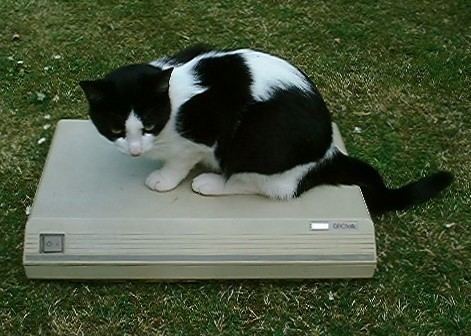DECtalk was a speech synthesizer and text-to-speech technology developed by Digital Equipment Corporation in 1984, based largely on the work of Dennis Klatt at MIT, whose source-filter algorithm was variously known as KlattTalk or MITalk.
The first DECtalk units were seen in 1984. They were standalone units that connected to any device with an asynchronous serial port. These units were also able to connect to the telephone system by having two telephone jacks. One connected to a phone line, the other to a telephone. The DECtalk units could recognize and generate any telephone touch tone. With that capability the units could be used to automate various telephone-related tasks by handling both incoming and outgoing calls. This included acting as an interface to an email system and the capability to function as an alerting system by utilizing the ability to place calls and interact via touch tones with the person answering the phone.
Later units were produced for PCs with ISA bus slots. In addition, various software implementations were produced, most notably the DECtalk Access32. Certain versions of the synthesizer were prone to undesirable characteristics. For example, the alveolar stops were often assimilated as sounding more like dental stops. Also, versions such as Access32 would produce faint electronic beeps at the end of phrases.
In the final years of DEC, early/mid-2000, the DECtalk IP was sold to Force Computers, Inc. In December 2001, the IP was sold from Force Computers, Inc, to Fonix Speech, Inc. (now SpeechFX, Inc.), which offers DECtalk as a small-footprint TTS system.
In technology and culture
The DECtalk engine was notably used in the US National Weather Service's first "Console Replacement System" (CRS) installations in the late 1990s for NOAA Weather Radio. As of 2003 it had all but been replaced by a far more modern engine called Speechify. The so-called "Perfect Paul" voice (a DECtalk "preset" for a default understandable male voice) still does Station identifications on many NWR stations.One of the early uses was a "text to voice" system that read an individual's emergency medical information (medications, allergies, doctor, insurance and contact info stored in a database) to hospitals telephoning in about patients presenting at emergency rooms. The company, Med-Fax, created by David Grober in 1986, used the DECtalk on an IBM platform, making it one of the early cross platform applications (DEC to IBM).DECtalk had a number of built-in voices which were identified by the following names: Perfect Paul (the default voice), Beautiful Betty, Huge Harry, Frail Frank, Kit the Kid, Rough Rita, Uppity Ursula, Doctor Dennis and Whispering Wendy. In addition the voices were editable by adjusting various parameters (such as throat size, crossover frequencies,etc.)DECtalk understood phonetic spellings of words, allowing customized pronunciation of unusual words. These phonetic spellings could also include a tone indicator which DECtalk would use when enunciating the phonetic components. This allowed DECtalk to sing.In addition, all the electronic voices in the movie Back to the Future II were created by personnel from the Digital Equipment Corporation's San Diego office, using the DECtalk TTS system.DECtalk can be used as part of a speech generating device for those unable to speak. A notable user is Stephen Hawking, who is unable to speak due to a combination of severe disabilities caused by ALS as well as an emergency tracheotomy. Hawking has used a version of the DECtalk voice synthesizer for several years and has come to be associated with the unique voice of the device. In 2011, Hawking's research assistant Sam Blackburn said Hawking still used a version of DECtalk identified on its board as the "Calltext 5010" manufactured in 1988 by SpeechPlus, Inc., because he identified with it and had not heard a voice he likes better. The CallText 5010 is still listed on Hawking's site as of 2015.The character "Dee Klatt" from Chipspeech was based on data from this device.
